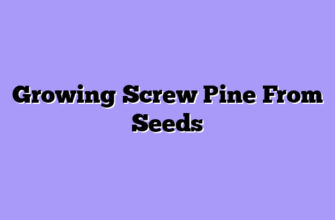What in the World is a Screw Pine?
First things first, let’s clear up any confusion. The screw pine, scientifically known as Pandanus tectorius, goes by many names. You might have heard it called hala fruit, thatch screwpine, Tahitian screwpine, or even pandanus. But don’t let the “pine” in its name fool you – this isn’t your typical Christmas tree we’re talking about!
Imagine a plant that looks like a cross between a palm tree and a pineapple, with long, spiky leaves arranged in a spiral pattern. That’s our screw pine! But the real star of the show is its fruit – a large, round, segmented ball that looks like it could be a prop from a sci-fi movie.

These seeds, when ripe, are surrounded by a soft, fibrous flesh that’s absolutely bursting with flavor. It’s like nature’s own candy, wrapped up in a package that’s admittedly a bit intimidating at first glance. But hey, isn’t that what makes exotic fruits so exciting?
The Adventure of Growing Screw Pines
Let me tell you, growing screw pines is not for the faint of heart. These plants are the divas of my farm, demanding just the right conditions to thrive. They love tropical climates, so unless you’re blessed with year-round warmth and humidity, you’re in for a challenge.
When I first started growing screw pines, I felt like I was trying to solve a Rubik’s cube blindfolded. They need well-draining soil, plenty of sunlight, and just the right amount of water. Too little, and they throw a fit. Too much, and they sulk. It’s like trying to please a temperamental teenager!
But oh, the satisfaction when you get it right! Watching a screw pine grow is like witnessing a slow-motion firework display. The leaves unfurl in their mesmerizing spiral pattern, reaching towards the sky like nature’s own sculpture.
And then there’s the waiting game. Screw pines take their sweet time to fruit – we’re talking years here, folks. But let me tell you, the wait is worth it. The day I saw my first screw pine fruit forming, I did a little happy dance right there in the field. My farmhands probably thought I’d lost my mind, but hey, when you’re passionate about exotic fruits, these are the moments you live for!
The Culinary Adventure: Cooking with Screw Pine Seeds
Now, let’s get to the good stuff – eating these little wonders! Screw pine seeds are incredibly versatile in the kitchen. The first time I tasted one, it was like a flavor explosion in my mouth. Imagine a hint of sweetness, a touch of nuttiness, and a subtle vanilla-like aroma all rolled into one.
In many Pacific Island cultures, screw pine seeds are a staple food. They can be eaten raw, but cooking them really brings out their unique flavor. I love roasting them – it gives them a delicious, nutty taste that’s out of this world. Toss them into salads, grind them into flour for baking, or use them as a garnish for desserts. The possibilities are endless!
One of my favorite ways to use screw pine seeds is in a traditional Polynesian pudding called “fāfā”. It’s a creamy, coconut-based dessert that’s simply divine. The screw pine seeds add a wonderful texture and flavor that’ll make your taste buds do a happy dance.
But it’s not just about the taste. Screw pine seeds are packed with nutrients too. They’re a good source of carbohydrates, fiber, and essential minerals. It’s like nature’s own multivitamin, wrapped up in a delicious package. How cool is that?
The Challenges and Rewards of Farming Screw Pines
Now, I won’t sugarcoat it – farming screw pines isn’t always a walk in the park. These plants can be pretty high-maintenance, and there have been times when I’ve questioned my sanity for choosing this path. But then I remember the unique joy that comes with cultivating something so extraordinary.
One of the biggest challenges is protecting the plants from pests and diseases. Screw pines can be susceptible to various fungal infections, and don’t even get me started on the birds and rodents that seem to think I’m running an all-you-can-eat buffet just for them! I’ve had to get creative with my pest control methods, let me tell you.
Then there’s the harvesting process. Remember those spiky leaves I mentioned? Yeah, they’re not just for show. Harvesting screw pine fruits is like playing a real-life game of Operation – one wrong move, and you’re nursing a nasty scratch. But over the years, I’ve developed a technique that’s part science, part artistry, and maybe a little bit of interpretive dance.
But you know what? Every challenge, every setback, every moment of frustration – it all fades away when I see people’s faces light up as they try screw pine seeds for the first time. There’s something magical about introducing someone to a flavor they’ve never experienced before. It’s like watching them discover a whole new world, right there on their plate.
The Future of Screw Pine Farming
As an exotic fruit farmer, I’m always looking towards the future. And let me tell you, I think screw pines have a bright one ahead. With more and more people seeking out unique and nutritious foods, I believe screw pine seeds are poised to become the next big thing in the culinary world.
I’m currently experimenting with different varieties of Pandanus tectorius, trying to develop strains that are more resistant to pests and diseases. It’s a slow process – we’re talking plant breeding here, not instant coffee – but I’m excited about the possibilities.
I’m also working on sustainable farming practices for screw pines. These plants play a crucial role in their native ecosystems, helping to prevent soil erosion and providing habitat for various species. As farmers, I believe we have a responsibility to cultivate these plants in a way that respects and preserves their natural environment.
And let’s not forget about education! I’m on a mission to spread the word about screw pine seeds far and wide. I host tasting events, give talks at local schools, and even run a little blog where I share recipes and growing tips. My dream is to see screw pine seeds become as common in kitchens as, say, almonds or cashews. Ambitious? Maybe. But hey, a farmer can dream, right?
Conclusion: The Joy of Exotic Fruit Farming
So there you have it, folks – a deep dive into the world of screw pine seeds from your friendly neighborhood exotic fruit farmer. It’s been quite a journey, from those first tentative steps into screw pine cultivation to where I am today. There have been ups and downs, triumphs and setbacks, but I wouldn’t trade it for anything in the world.
Every time I walk through my screw pine orchard, watching the sunlight filter through those spiral leaves, I’m filled with a sense of wonder. These incredible plants, with their alien-like fruits and delicious seeds, never cease to amaze me. They’ve taught me patience, perseverance, and the joy of nurturing something truly unique.
To all you adventurous eaters out there, I say this: next time you have the chance, give screw pine seeds a try. Who knows? You might just discover your new favorite fruit. And to my fellow farmers or aspiring growers, if you’re looking for a challenge that’ll test your skills and reward you with something extraordinary, consider the humble screw pine.
As for me, I’ll be here on my farm, tending to my spiky charges, dodging the occasional projectile leaf, and eagerly awaiting each new harvest. Because at the end of the day, there’s nothing quite like the satisfaction of bringing something as unique and delicious as screw pine seeds to the world. Happy farming, and happy eating!








